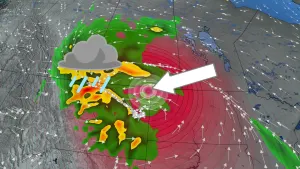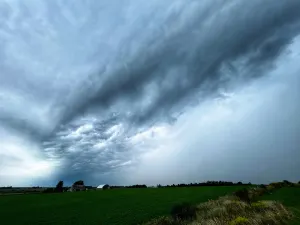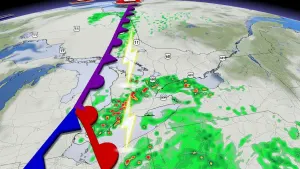
Look up this Fall to see Jupiter at its brightest in over 70 years!
Additionally, watch for a total lunar eclipse in November, and at least a half dozen meteor showers (and a possible meteor swarm) throughout the season.
As the nights grow longer and the weather cools down, Fall is a great season to stay out late to stargaze. As an added bonus, this time of the year has so many meteor showers that several of them overlap.
For Fall of 2022, there are some extra special treats in our night skies. Jupiter is at its brightest in decades, Canadians will be seeing another total lunar eclipse, and we may even be treated to a special meteor swarm!
Here is our guide to the astronomical sights on display for the coming season:
Sep 22: Fall Equinox (northern hemisphere)
Sep 23-Oct 7: Zodiacal Light in the east before dawn for 2 weeks
Sep 26: Jupiter Opposition (closest and brightest in 71 years!)
Oct 5: Waxing Gibbous Moon near Saturn
Oct 8: Nearly Full Moon close to Jupiter
Oct 9: Full Hunter's Moon
Oct 9: Draconids Meteor Shower peak
Oct 10: Southern Taurid meteor shower peak (?)
Oct 14: Waning Gibbous Moon near Mars
Oct 20-21: Orionid Meteor Shower peak
Oct 23-Nov 6: Zodiacal Light in the east before dawn for 2 weeks
Oct 24-Nov 11: Possible Taurid Meteor Swarm
Oct 25: Partial Solar Eclipse (Europe, Western Asia, NE Africa)
Nov 1: First Quarter Moon near Saturn
Nov 4: Waxing Gibbous Moon near Jupiter
Nov 5-6: Southern Taurid meteor shower peak (?)
Nov 8: Full Beaver Moon, Total Lunar Eclipse
Nov 10-11: Waning Gibbous Moon near Mars
Nov 11-12: Northern Taurid meteor shower peak
Nov 17-18: Leonid meteor shower peak
Nov 26: Perigee waxing crescent moon
Nov 28: Waxing Crescent Moon near Saturn
Dec 1: Mars at closest approach to Earth
Dec 1-2: Waxing Gibbous Moon near Jupiter
Dec 7-8: Full Cold Moon, Moon occults Mars
Dec 13-14: Geminid meteor shower peak
Dec 21: Winter Solstice (northern hemisphere)
Visit our Complete Guide to Fall 2022 for an in-depth look at the Fall Forecast, tips to plan for it and much more!
The Zodiacal Light
Have you ever been out in the hours just after sunset or before sunrise and noticed a bright pyramid of light covering a significant portion of the sky? If so, you may have seen an elusive phenomenon known as the Zodiacal Light.
Between the dates of September 23 and October 7, turn your gaze to the eastern horizon in the half hour before morning twilight. Specifically, you are looking for a diffuse white glow in the shape of a pyramid, with its base along the horizon and peak extending high into the sky. If you miss it during those dates, the phenomenon is visible again, at the same time of the morning, between October 23 and November 6.
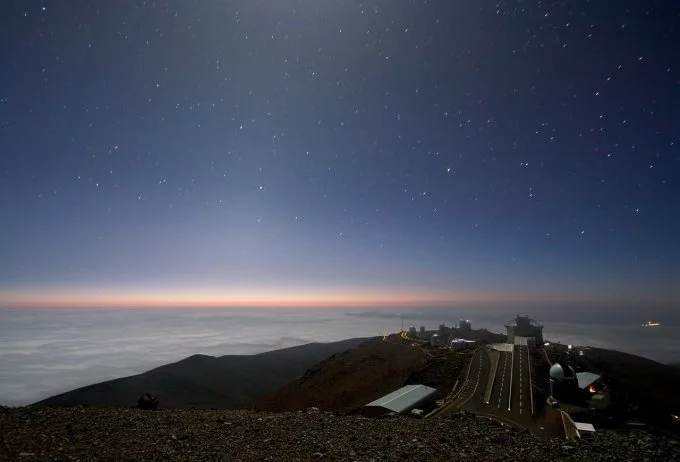
Moonlight and zodiacal light over La Silla. Credit: European Southern Observatory (ESO)
The zodiacal light is produced by sunlight glinting off grains of dust that float in an immense disk surrounding the Sun. However, we can only see this effect at specific times of the year. In February and March, it appears in the western sky, in the half-hour after evening twilight, in the two weeks just after the Full Moon. In September and October, we can see it in the eastern sky, in the half-hour or so before morning twilight, during the two weeks following the New Moon.
New research has shed fresh light on this phenomenon. It was once thought that the dust cloud that produces the zodiacal light originated from comet tails. However, researchers used data from NASA's Juno spacecraft to reveal it may actually be Martian dust floating in space!
The best way to be sure that you really are seeing this phenomenon is to look up the exact timing of twilight in your area so that you know precisely when it begins, and get away from city lights so that you are sure light pollution isn't going to spoil the view.
Jupiter Opposition
Have you noticed Jupiter getting brighter and brighter lately? There's a very good reason for that: On September 26, the planet will reach its closest distance to Earth for 2022, in an event called Opposition.
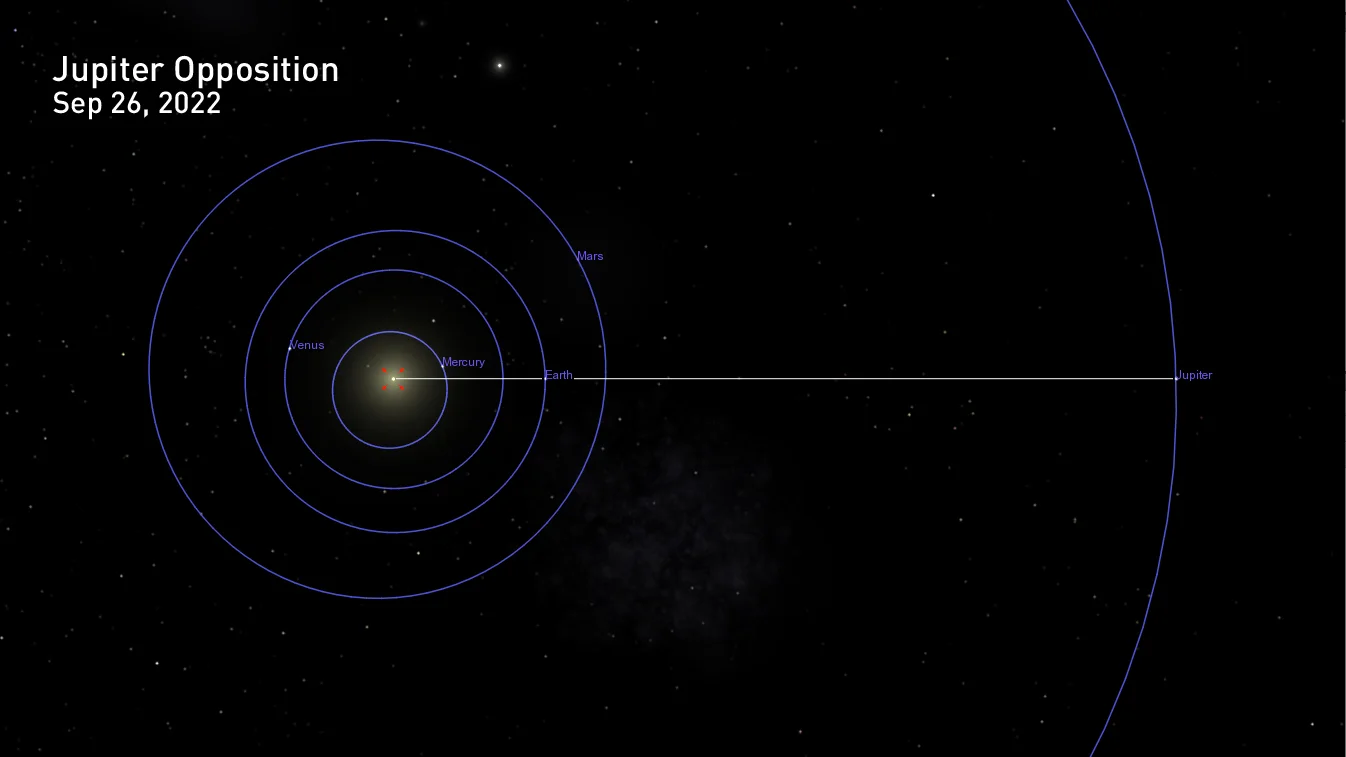
The alignment of the planets on Sep 26, 2022, as the Sun, Earth, and Jupiter line up together. Credit: Celestia
This is something that occurs every 13 months or so, as Earth 'laps' Jupiter in their orbits around the Sun. At that time (roughly 4 p.m. ET on the 26th), Jupiter will be positioned on the exact opposite side of Earth from the Sun (thus the name "opposition").
Jupiter will be at a distance of just under 591.3 million kilometres on the 26th. The last time it was closer was on October 2, 1951, when it came within 590.7 million km of Earth.
So, we'll be seeing Jupiter at its brightest in nearly 71 years!

The night sky on September 26, showing off Jupiter during Opposition. The inset shows what the planet and its four largest satellites will look like through a telescope or a good pair of binoculars. Credit: Stellarium/Scott Sutherland
According to NASA, it will be an even longer wait before Jupiter comes even closer and thus shines even brighter — 107 years from now, to be exact. Based on the Jet Propulsion Lab's HORIZONS system, on October 6, 2129, the planet will reach opposition at just 590.6 million km away. That's even closer than its approach in 1951!
So, with the giant planet so bright in our sky right now, it represents an exceptional opportunity! This is a great time for astronomers of all skill levels to get outside and point their telescopes or binoculars at Jupiter, to see it at its best!
The Moon and the Planets
The three Full Moons of the Fall season occur on October 9 (Full Hunter's Moon), November 8 (Full Beaver Moon), and December 8 (Full Cold Moon).
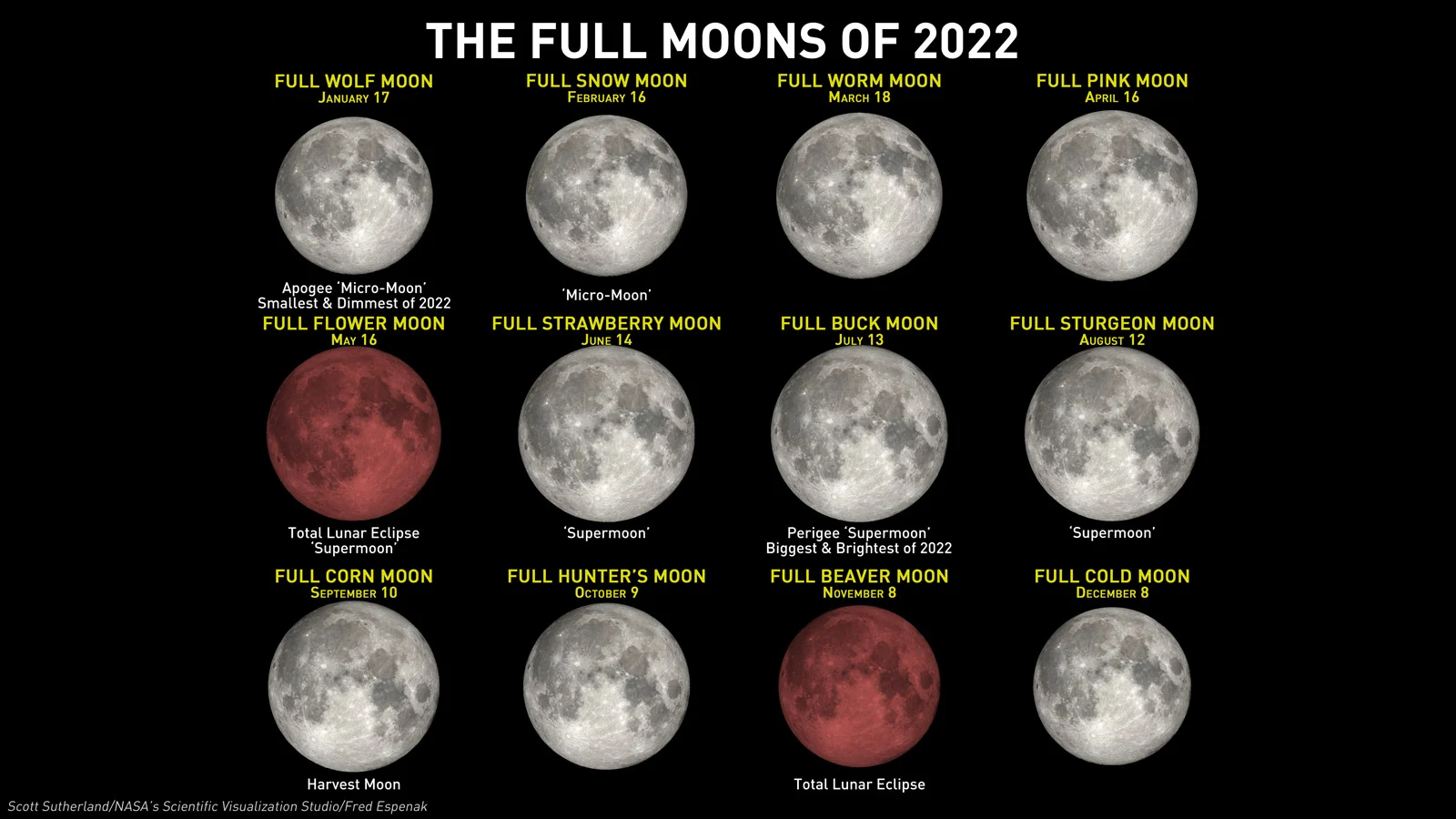
The 12 Full Moons of 2022, including their popular names and any other notable facts — supermoons, micromoons, lunar eclipses, etc. Credit: Scott Sutherland/NASA GSFC, with data from Fred Espenak
Additionally, November's Full Beaver Moon is also the second total lunar eclipse of this year!
In the predawn hours of November 8, the Full Moon will pass through Earth's shadow, turning a dusky red colour in the process.

While May's Super Blood Flower Moon favoured the eastern half of Canada, this one will be best seen from the western half of the country. We'll provide more details on the timing of this event closer to November.
The Full Moon isn't the only celestial object to see in the night sky this season.
Three bright planets are visible every night, stretching in an arch across the sky. Saturn will already be high in the sky when the Sun sets. It will be followed by Jupiter rising in the early evening and Mars in the late evening. Finally, Venus even makes appearances in the predawn sky early in the season.
The Moon swings past Saturn, Jupiter, and Mars each month, as well. Look for it near Saturn on Oct. 5, Nov. 1, and Nov. 28. It will pair up with Jupiter on Oct. 8, Nov. 4, and Dec. 1. You can see it near Mars on Oct. 14, Nov. 10, and Dec. 7.
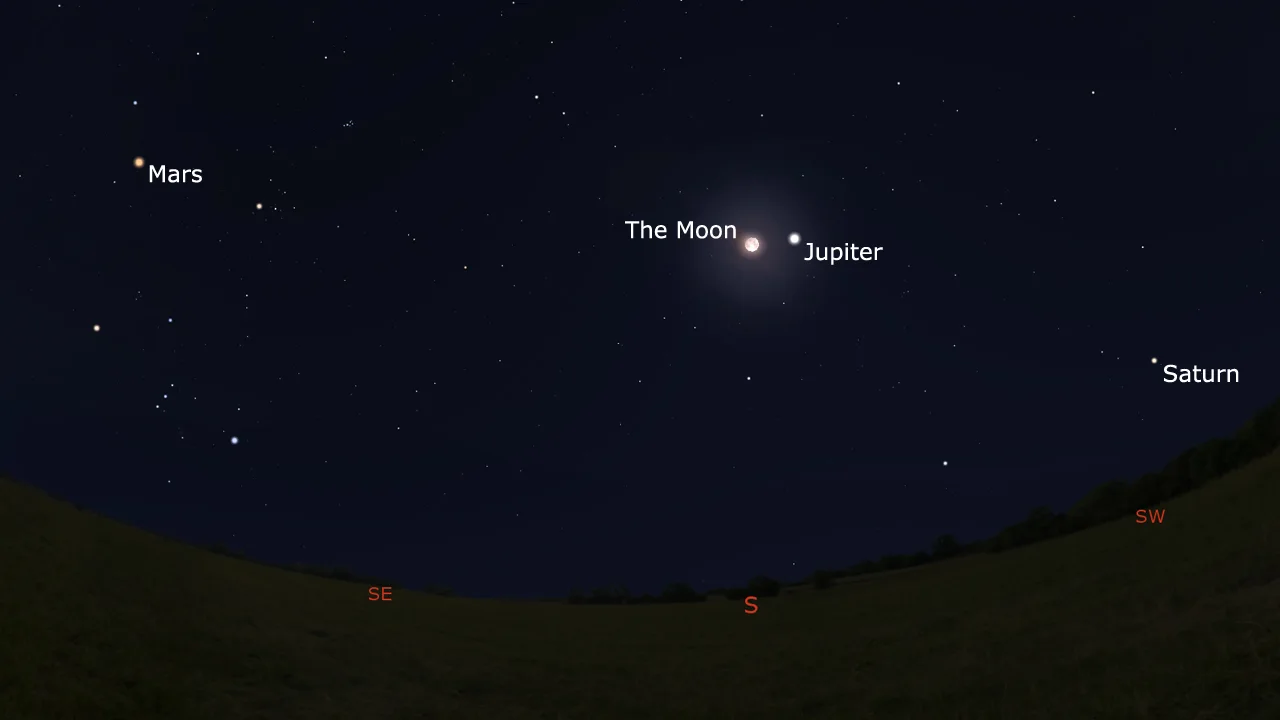
The night sky on October 8, 2022, when the Full Hunter's Moon will pair up with Jupiter, with Saturn off to the west and Mars to the east. Credit: Stellarium
The December 7 encounter between the Full Cold Moon and Mars is a special one, too.
Coincidentally, Dec 7 is the date of Mars Opposition, when the planet is on the exact opposite side of Earth from the Sun. So, the Sun, Earth, the Full Moon, and Mars will all line up perfectly during this event. Starting around 10:30 p.m. EST, Mars will briefly disappear behind the Moon and reappear about 40 minutes later.

The occultation of Mars on the night of Dec 7. Credit: Stellarium/Scott Sutherland
The Season of Meteor Showers
Meteor showers occur when Earth passes through streams of icy, dusty debris left behind by comets and certain asteroids. When this happens, the bits of debris in the streams produce streaks of light in our night skies.
Of the four seasons of the year, Fall has the greatest number of meteor showers. While there are many meteor showers throughout the year, roughly a dozen are best known for being reliable nighttime events. Nearly half of these occur in Fall.
The Draconids meteor shower is the first of the season. It peaks on Oct. 9, just one night after the Full Moon. Fortunately, the meteors stream out of the northern sky, so it's a simple matter to turn your back to the Moon while you watch the show.
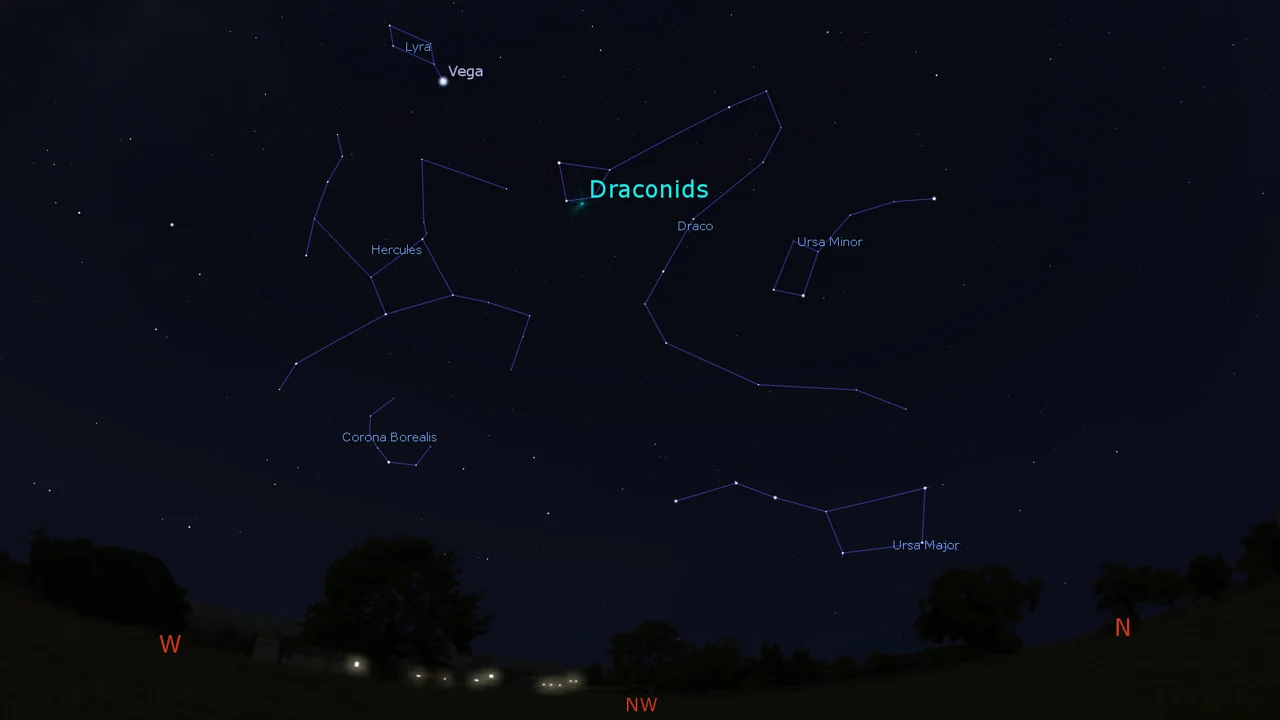
The night sky during the peak of the Draconids. Credit: Stellarium
Although the Draconids have put on some of the most spectacular meteor displays of the 20th century, outbursts from this shower are somewhat rare. This year, it will likely produce around 10 meteors per hour.
The Orionids, the second of two yearly meteor showers from Halley's Comet, lasts for nearly the entire month of October. It's known for producing bright meteors and can deliver up to 20 per hour during the peak on the night of October 20-21. Timed as it is, with only a Waning Crescent Moon rising in the predawn sky, this could be the best of the early autumn meteor showers.

The best viewing for the Orionid meteor shower will be in the hours before sunrise on Oct 21. Credit: Stellarium/Scott Sutherland
Twin meteor showers — the southern and northern Taurids — overlap in October and November, not only on the days they occur but also where their meteors appear from in the night sky.
It's no coincidence though. These two meteor showers apparently come from the same object, at least originally. Long ago, a comet called 2P/Encke broke apart, leaving behind two large pieces, a bunch of smaller fragments, and a lot of dust. One of the large leftover pieces is still referred to as Comet Encke, while the other is an asteroid called 2004 TG10. The two have drifted apart significantly over the years due to the gravitational infuence of the planets. Now each has its own stream of dust and debris, which produce the two Taurid showers — the Southern Taurids from Comet Encke and the Northern Taurids from asteroid 2004 TG10.
There's something else a little unusual about these two, as well. While everyone agrees that the Northern Taurids peak on November 11, depending on who you ask, the Southern Taurids peak either on October 10 or November 5.
Neither of these is a particularly strong meteor shower, though, and they won't be very well timed for the phases of the Moon. So, this likely won't be a good year to settle any debate about Taurid peaks.
However, according to the International Meteor Organization (IMO), we may see something special in the last week of October and the first two weeks of November — a Taurid Meteor Swarm!
This Taurid swarm shows up as an unusually high number of fireball meteors, all originating from the constellation Taurus, during this roughly three-week period. These fireballs are caused by a 'clump' of pebble-sized fragments embedded within the debris stream of Comet Encke. Of course, there's no guarantee the swarm will happen this year, but it's definitely worth checking out if it does.
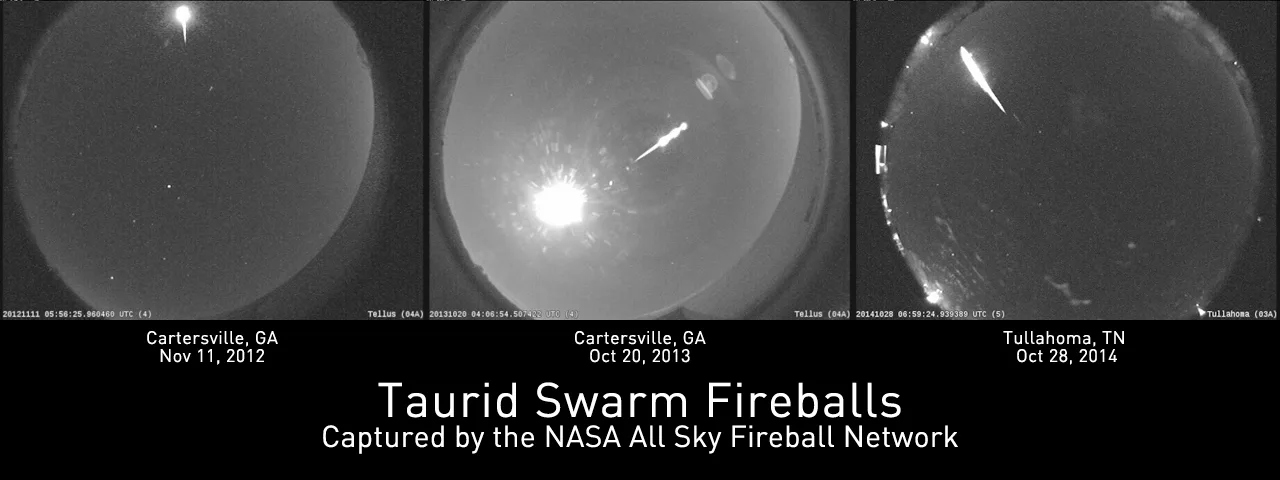
Three Taurid swarm fireballs captured by the NASA All Sky Fireball Network in 2012, 2013 and 2014. Credit: NASA
The Leonids are another weak meteor shower of the season, producing meteors throughout most of November. During the peak, which takes place on November 17-18, viewers can see up to 10 meteors per hour, similar to the Draconids.
One of the three best meteor showers of the year comes around towards the end of Fall.
The Geminid meteor shower, which originates from 'rock comet' asteroid 3200 Phaethon, can be seen anytime from the 4th to the 20th of December. This year, the shower's peak occurs on the night of the 13th to the 14th.
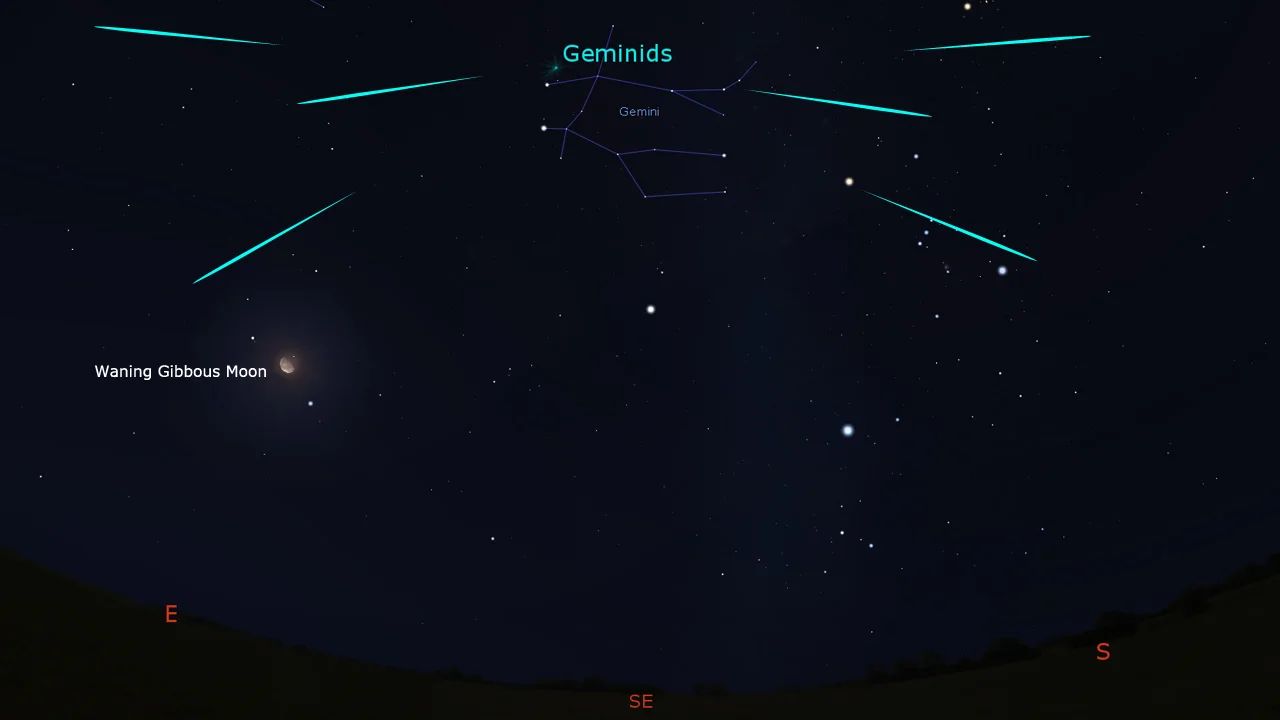
The night sky on Dec. 13-14, during the peak of the Geminid meteor shower. Credit: Stellarium/Scott Sutherland
While the Waning Gibbous Moon is not the most favourable for this event, the Geminids can produce up to 100 meteors or more per hour during the peak. Thus, as long as viewers keep the Moon out of their direct line of sight, they can still enjoy this yearly show.
Partial Solar Eclipse
Although it won't be directly visible from anywhere in Canada, in the predawn hours on October 25, the Moon will slip across the Sun, producing a partial solar eclipse.
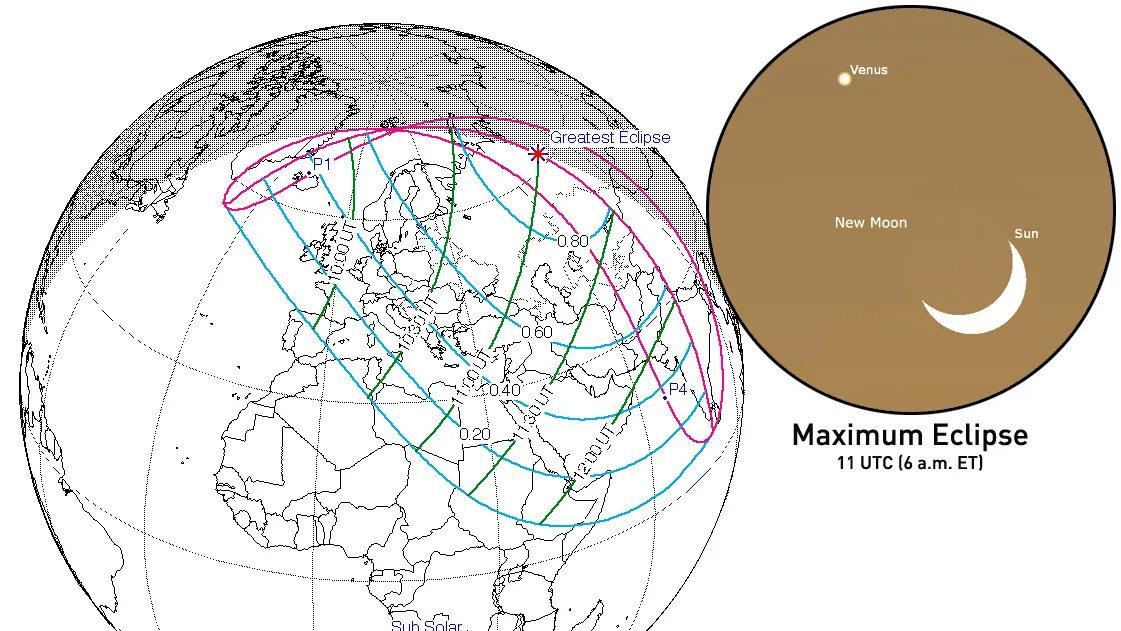
This map shows the regions of the world where the October 25 partial solar eclipse will be visible from, with the inset image showing what the eclipse will look like at maximum (including an appearance from Venus). Credit: NASA/Stellarium
The Sun, Moon and Earth won't be in perfect alignment for this event. Thus, the Moon will only partially cover up the disk of the Sun — roughly 86 per cent of it when the eclipse reaches its maximum.
The eclipse will only be visible from Europe, western Asia, and northeastern Africa. There are bound to be livestreams set up from various locations, and there are sure to be images posted online during and after the event.
Tips for Watching a Meteor Shower
Meteor showers are events that nearly everyone can watch. No special equipment is required. In fact, binoculars and telescopes make it harder to see meteor showers, by restricting your field of view. However, there are a few things to keep in mind so you don't miss out on these amazing events.
The three best practices for observing the night sky are:
Check the weather,
Get away from light pollution, and
Be patient.
Clear skies are essential. Even a few hours of cloudy skies can ruin your chances of watching an event such as a meteor shower. So, be sure to check The Weather Network on TV, on our website, or from our app, and look for my articles on our Space News page, just to be sure that you have the most up-to-date sky forecast.
Next, you need to get away from city light pollution. If you look up into the sky from home, what do you see? The Moon, a planet or two, perhaps a few bright stars such as Vega, Betelgeuse and Procyon, as well as some passing airliners? If so, there's too much light pollution in your area to get the most out of a meteor shower. You might catch an exceptionally bright fireball if one happens to fly past overhead, but that's likely all you'll see. So, to get the most out of your stargazing and meteor watching, get out of the city. The farther away you can get, the better.
Watch: What light pollution is doing to city views of the Milky Way
For most regions of Canada, getting out from under light pollution is simply a matter of driving outside of your city, town or village until a multitude of stars is visible above your head.
In some areas, especially in southern Ontario and along the St. Lawrence River, the concentration of light pollution is too high. Getting far enough outside of one city to escape its light pollution tends to put you under the light pollution dome of the next city over. The best options for getting away from light depend on your location. In southwestern Ontario and the Niagara Peninsula, the shores of Lake Erie can offer some excellent views. In the GTA and farther east, drive north and seek out the various Ontario provincial parks or Quebec provincial parks. Even if you're confined to the parking lot after hours, these are usually excellent locations from which to watch (and you don't run the risk of trespassing on someone's property).
If you can't get away, the suburbs can offer at least a slightly better view of the night sky. Here, the key is to limit the amount of direct light in your field of view. Dark backyards, sheltered from street lights by surrounding houses and trees, are your best haven. The video above provides a good example of viewing based on the concentration of light pollution in the sky. Also, check for dark sky preserves in your area.
When viewing a meteor shower, be mindful of the phase of the Moon. Meteor showers are typically at their best when viewed during the New Moon or Crescent Moon. However, a Gibbous or Full Moon can be bright enough to wash out all but the brightest meteors. Since we can't get away from the Moon, the best option is just to time your outing right, so the Moon has already set or is low in the sky. Also, you can angle your field of view to keep the Moon out of your direct line of sight. This will reduce its impact on your night vision and allow you to spot more meteors.
Once you've verified you have clear skies and you've limited your exposure to light pollution, this is where being patient comes in.
For best viewing, your eyes need some time to adapt to the dark. Give yourself at least 20 minutes, but 30-45 minutes is best for your eyes to adjust from being exposed to bright light.
Note that this, likely more than anything else, is the one thing that causes the most disappointment when it comes to watching a meteor shower.
If you step out into your backyard from a brightly lit home and looking up for a few minutes, you might be lucky enough to catch a rare bright fireball meteor. However, it's far more likely that you won't see anything at all. Meteors may be streaking overhead, but it takes time for our eyes to adjust, so that we can actually pick out those brief flashes of light. Waiting for at least twenty minutes, while avoiding sources of light during that time (streetlights, car headlights and interior lights, and smartphone and tablet screens) dramatically improves your chances of avoiding disappointment.
Sometimes, avoiding your smartphone or tablet isn't an option. In this case, set the display to reduce the amount of blue light it gives off and reduce the screen's brightness. That way, it will have less of an impact on your night vision.
You can certainly gaze into the starry sky while you are letting your eyes adjust. You may even see a few of the brighter meteors as your eyes become accustomed to the dark.
Once you're all set, just look straight up and enjoy the view!
Thumbnail image is Hubble's 2019 portrait of Jupiter, courtesy NASA, ESA, A. Simon (Goddard Space Flight Center), and M.H. Wong (University of California, Berkeley)







